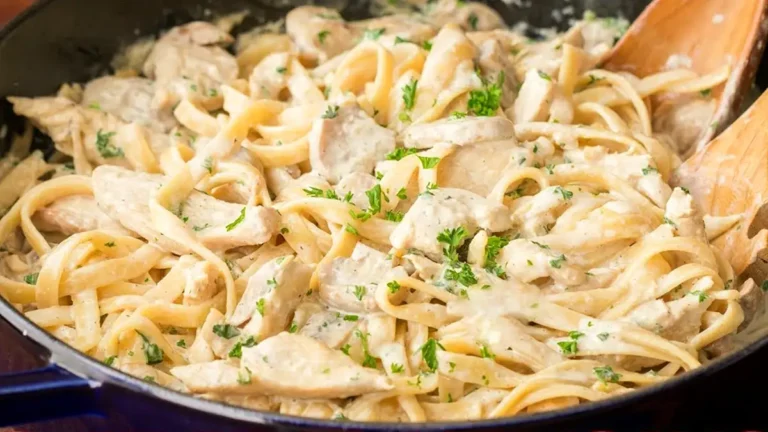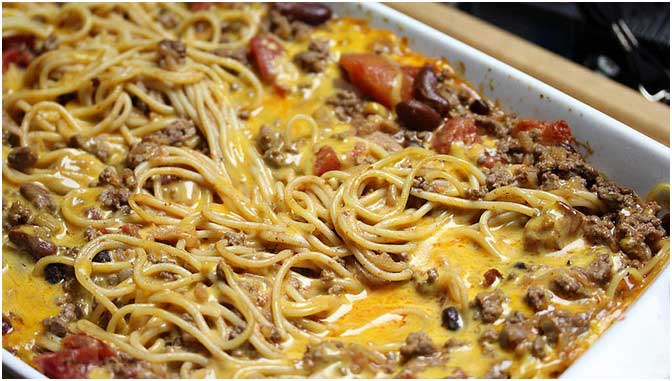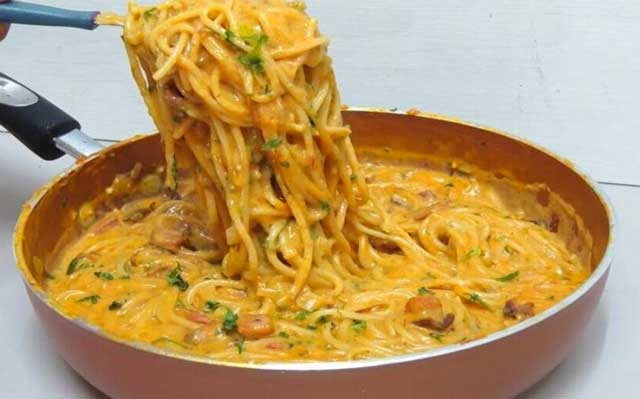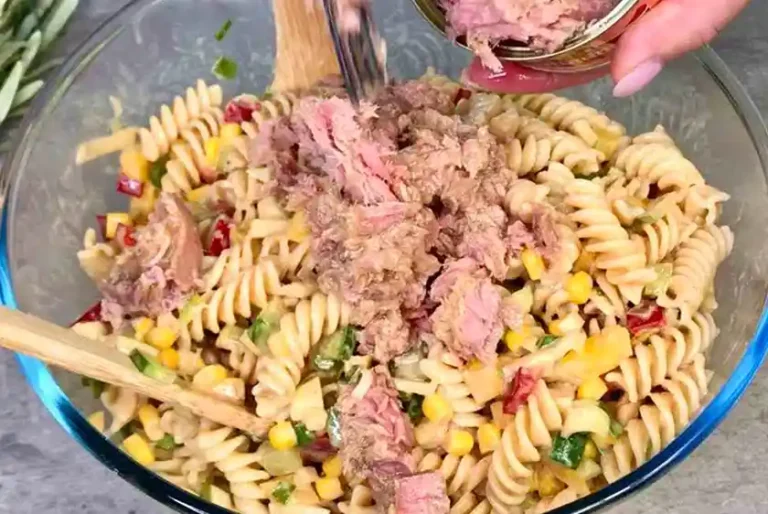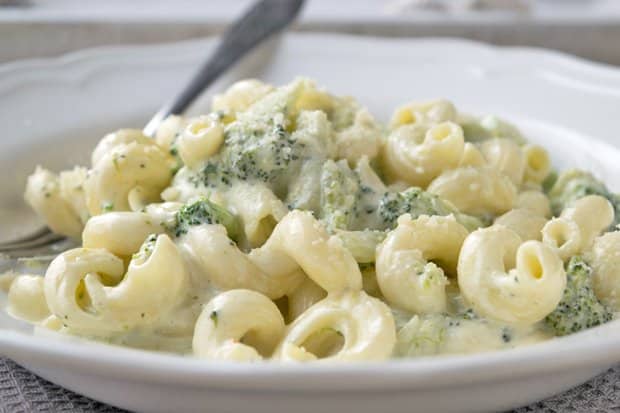Asiapfanne mit Eiernudeln und Gemüse Rezept
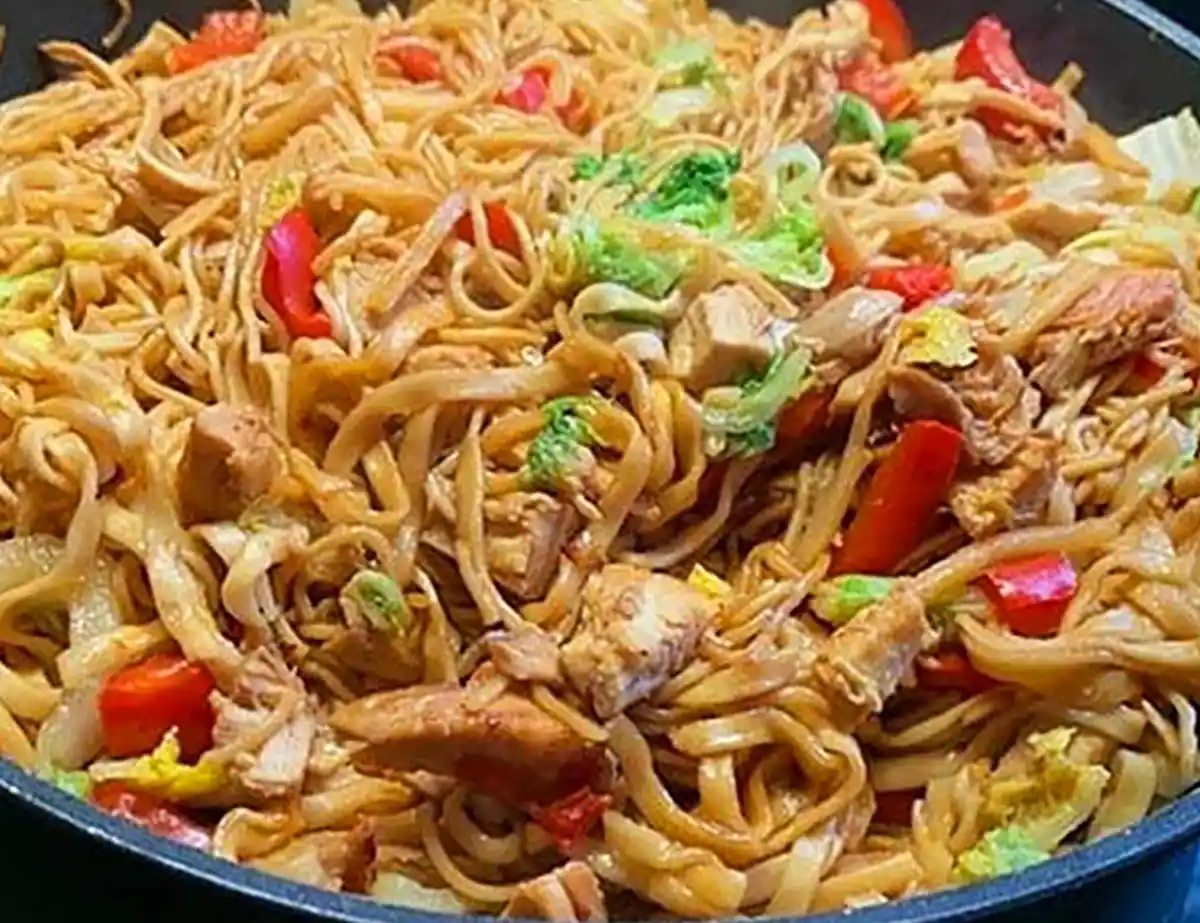
Asiapfanne mit Eiernudeln: Schnelle Küche, voller Geschmack und wenig Aufwand
Wer kennt das nicht? Ein hektischer Tag, wenig Zeit – und trotzdem will man etwas Frisches, Gesundes auf dem Tisch haben. Genau deshalb ist die asiapfanne mit eiernudeln für mich zum echten Lieblingsrezept geworden. Sie vereint kräftige Aromen, knackiges Gemüse und zarte Eiernudeln in einer einzigen Pfanne. Und das Beste: Alles ist in unter einer halben Stunde fertig. Noch Fragen?
Ich hab‘ dieses Gericht in den letzten Jahren bestimmt zwanzigmal zubereitet – manchmal mit Erfolg, manchmal mit kleinen Katastrophen (dazu später mehr!). Es ist ein asiapfanne rezept, das immer wieder begeistert. Ob als schnelles Abendessen nach der Arbeit, für Gäste oder auch einfach, wenn ich mal wieder Lust auf etwas Exotisches habe. Die eiernudeln mit gemüse machen einfach satt und glücklich.
3 wichtige Schritte für perfekte Konsistenz bei asiatischen Pfannengerichten
Die asiapfanne mit eiernudeln lebt von der richtigen Garzeit. Und genau da lag bei mir anfangs der Hund begraben: Entweder war das Gemüse zu weich, oder die Nudeln klebten zusammen. Nach etlichen Versuchen hab‘ ich drei Dinge gelernt, die wirklich einen Unterschied machen:
- Gemüse immer einzeln blanchieren – dann bleibt alles bissfest und verliert nicht die Farbe.
- Eiernudeln direkt nach dem Kochen kalt abschrecken und abtropfen lassen. Dadurch klebt später nichts und sie nehmen die Sauce besser auf.
- Putenfleisch scharf anbraten, aber nicht zu lange – sonst wird es trocken. Lieber kurz ruhen lassen, während das Gemüse in die Pfanne kommt.
Es klingt simpel, aber diese Schritte sparen Zeit und Nerven. Besonders, wenn der Hunger schon groß ist!
Welche rote Currypaste sorgt für die richtige Schärfe?
Ein Punkt, der für mich immer wieder spannend ist: Die Wahl der Currypaste. Rote Currypaste gibt’s in mild, scharf und höllisch scharf – da hilft wirklich nur ausprobieren. Ich starte meistens mit einem Teelöffel, probiere dann und gebe lieber noch etwas dazu. Denn einmal zu scharf, bleibt nur noch mehr Kokosmilch (schon ausprobiert, bringt aber auch nicht immer die Rettung!).
Falls Kinder mitessen, nehme ich wirklich nur einen Hauch und stelle die Paste extra auf den Tisch. So kann jeder nachwürzen. Bei der asiatische pfanne mit pute ist es ja gerade die Sauce, die das Gericht ausmacht. Mein Tipp: Immer vorsichtig dosieren und erst am Ende endgültig abschmecken.
Schnelle Asia Pfanne aus dem Vorrat – was tun, wenn mal eine Zutat fehlt?
Die Realität sieht doch oft so aus: Man steht am Herd, dann fällt auf – die Zuckerschoten sind alle, oder die Karotten sind schon leicht schrumpelig. Ich hab‘ gelernt: Die Basiszutaten machen das Gericht, aber ein bisschen improvisieren schadet nie. Brokkoli, Paprika und Putenfleisch sind für mich gesetzt. Wer mag, kann aber auch Spinat, Champignons oder sogar etwas Pak Choi dazugeben. Die asiapfanne mit eiernudeln bleibt flexibel – nur die genannten Zutaten müssen für das klassische Grundrezept natürlich immer dabei sein!
Und was ist, wenn die Eiernudeln mal ausgehen? Reisbandnudeln oder Glasnudeln funktionieren zur Not auch, aber ehrlich gesagt: Mit Eiernudeln schmeckt es einfach am besten. Da gibt’s keine Diskussion.
10 Jahre Erfahrung: Fehler, die ich nie wieder mache
Nach so vielen Asiapfannen hab‘ ich mir eine kleine Liste gemacht, was ich nie wieder falsch mache. Vielleicht hilft sie dir ja auch:
- Nie zu viel Gemüse auf einmal in den Wok geben – lieber in Etappen, sonst wird alles gedämpft statt gebraten.
- Keine Angst vor hoher Hitze, aber immer dabei bleiben. Sonst brennt die Currypaste schnell an.
- Die Sauce erst ganz am Schluss abschmecken. Wenn sie zu früh rein kommt, verkocht das Aroma.
- Kokosmilch immer gut umrühren, sonst gibt’s Klümpchen.
Gerade bei der schnelle asia pfanne ist die Reihenfolge entscheidend. Einmal nicht aufgepasst, und schon ist das Gemüse matschig oder das Fleisch trocken. Aber keine Sorge: Nach ein paar Mal klappt’s wie am Schnürchen.
Zutatenliste für die klassische Asiapfanne mit Eiernudeln und Gemüse
Damit du direkt loslegen kannst, hier die Zutaten im Überblick. Ich halte mich immer an diese Angaben – Abwandlungen kommen später!
- 500 g Putenfleisch, in Streifen geschnitten
- 100 g chinesische Eiernudeln, schnellkochend
- 1 Dose ungesüßte Kokosmilch
- 1 Kopf Brokkoli
- 2 dicke Karotten
- 10 Zuckerschoten
- 1 rote Paprikaschote
- Rote Currypaste
- Salz
- Pfeffer
- Gemüsebrühe
- Zucker
Zubereitung:
- Alle Zutaten vorbereiten: Brokkoli waschen, in Röschen teilen und in Stücke schneiden. Karotten schälen, waschen und in Streifen schneiden. Zuckerschoten waschen, Fäden entfernen und halbieren. Paprika waschen, entkernen und in Streifen schneiden. Putenfleisch ggf. in Streifen schneiden.
- Wasser zum Kochen bringen, Eiernudeln nach Packungsanweisung garen, abgießen und beiseitestellen.
- Gemüse blanchieren: Brokkoli, Karotten und Zuckerschoten jeweils 1-2 Minuten in kochendem Wasser bissfest garen, herausnehmen und in kaltem Wasser abschrecken.
- Öl in einer großen Pfanne oder einem Wok erhitzen, Paprika 1-2 Minuten anbraten, herausnehmen.
- Bei Bedarf erneut etwas Öl erhitzen, Putenfleisch auf hoher Hitze rundherum goldbraun und durchgaren, herausnehmen.
- Blanchiertes Gemüse und Paprika zum Fleisch geben, alles gut vermengen.
- Eiernudeln hinzufügen und gründlich mit Fleisch und Gemüse vermengen.
- Kokosmilch zugießen, umrühren, sodass alles gleichmäßig bedeckt ist.
- Rote Currypaste nach Geschmack einrühren, ggf. Gemüsebrühe dazugeben, falls die Sauce zu dick ist.
- Mit Salz, Pfeffer und einer Prise Zucker abschmecken. Noch ein paar Minuten köcheln lassen, bis alles gut erhitzt ist.
- Sofort heiß servieren, nach Wunsch mit Koriander oder Sesam bestreuen.
Fazit: Warum asiapfanne mit eiernudeln immer wieder überzeugt
Dieses Gericht ist für mich ein echter Alleskönner. Egal wie stressig der Tag war, die asiapfanne mit eiernudeln steht in unter 30 Minuten auf dem Tisch – und schmeckt jedes Mal ein bisschen anders, weil die Gewürze so wandelbar sind. Sie ist gesund, bunt und macht satt. Und ehrlich: Was will man mehr? Probier’s einfach aus, trau dich an die Currypaste, und lass dich vom Duft überraschen. Ich freu mich auf dein Feedback – und falls du einen Trick kennst, den ich noch nicht ausprobiert habe, immer her damit!
Tipps & Tricks rund ums asiapfanne rezept: Alles, was du wissen musst!
Kann ich das Putenfleisch in der asiapfanne mit eiernudeln durch etwas anderes ersetzen?
Klar, das klappt super! Wenn du kein Putenfleisch magst oder gerade keines da hast, kannst du auch Hähnchen, Rind oder sogar Tofu nehmen. Ich habe die asiapfanne auch schon mal mit Garnelen gemacht – war richtig lecker! Wichtig ist, dass du alles in Streifen schneidest, damit es gleichmäßig gart.
Wie lange hält sich die asiapfanne mit eiernudeln im Kühlschrank?
Im Kühlschrank hält sich das Gericht etwa 2-3 Tage, wenn du es in einer luftdichten Dose aufbewahrst. Ich finde sogar, dass die Aromen am nächsten Tag noch intensiver sind! Du solltest die asiapfanne aber immer gut durch erhitzen, bevor du sie nochmal isst.
Kann ich das Gericht einfrieren?
Einfrieren geht grundsätzlich, aber die Konsistenz der Eiernudeln leidet manchmal ein bisschen (die werden nach dem Auftauen weicher). Wenn dich das nicht stört – ab in die Gefriertruhe! Zum Einfrieren lasse ich das Gericht komplett abkühlen und packe es portionsweise ein.
Was kann ich tun, wenn die Sauce zu dünn oder zu dick wird?
Wenn die Sauce zu dünn ist, lasse ich sie einfach noch ein bisschen ohne Deckel einkochen. Ist sie zu dick, hilft ein Schuss Gemüsebrühe oder Kokosmilch. Pass einfach auf, dass du nicht zu viel auf einmal nachkippst – lieber nach und nach, dann hast du die Konsistenz besser im Griff.
Für welche Anlässe eignet sich die schnelle asiapfanne besonders gut?
Ich mache sie gerne, wenn es schnell gehen muss oder Gäste spontan vorbeikommen – macht ordentlich was her und geht fix! Auch für Meal Prep ist die asiapfanne mit eiernudeln super, weil sie sich gut vorbereiten lässt und am nächsten Tag immer noch schmeckt.
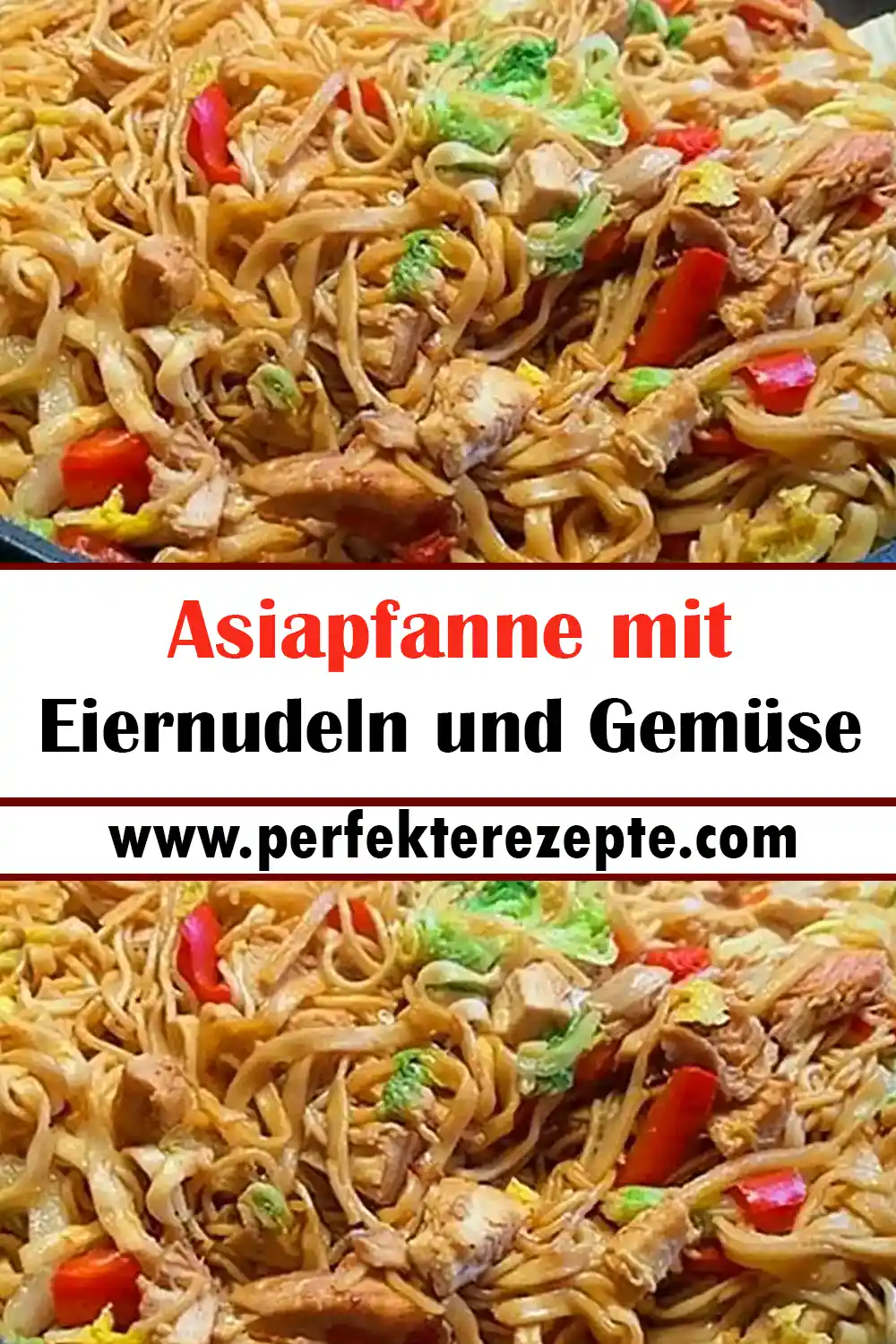
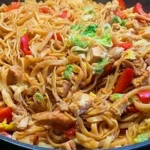
Asiapfanne mit Eiernudeln und Gemüse Rezept
- Total Time: 30
- Yield: 2 Portionen 1x
Description
Zarte Putenstreifen und knackiges Gemüse vereinen sich mit seidigen Eiernudeln in einer cremigen, aromatisch-scharfen Kokos-Curry-Sauce. Bunte Farben, frischer Biss, exotisch-würziger Duft – ein Fest für alle Sinne.
Ingredients
- 500 g Putenfleisch, in Streifen geschnitten
- 100 g chinesische Eiernudeln, schnellkochend
- 1 Dose Kokosmilch, ungesüßt
- 1 Kopf Brokkoli
- 2 dicke Karotten
- 10 Zuckerschoten
- 1 rote Paprikaschote
- rote Currypaste
- Salz und Pfeffer
- Gemüsebrühe
- Zucker
Instructions
- Beginnen Sie damit, das gesamte Gemüse vorzubereiten. Waschen Sie den Brokkoli gründlich und trennen Sie die Röschen vom Strunk ab. Schneiden Sie die Brokkoliröschen in mundgerechte Stücke. Waschen und schälen Sie die Karotten. Schneiden Sie die Karotten in dünne, gleichmäßige Streifen, damit sie gleichmäßig garen. Die Zuckerschoten waschen, die Enden abschneiden und die Schoten anschließend halbieren. Die rote Paprikaschote waschen, entkernen und in feine Streifen schneiden. Stellen Sie das vorbereitete Gemüse beiseite.
- Bringen Sie einen großen Topf mit Wasser zum Kochen. Geben Sie die chinesischen Eiernudeln in das kochende Wasser und kochen Sie sie gemäß den Anweisungen auf der Verpackung, meist dauert dies nur wenige Minuten. Sobald die Nudeln gar sind, gießen Sie sie in ein Sieb ab und stellen sie beiseite.
- Blanchieren Sie nun das vorbereitete Gemüse, mit Ausnahme der Paprika. Füllen Sie einen Topf mit Wasser und bringen Sie es zum Kochen. Geben Sie die Brokkoliröschen, Karottenstreifen und Zuckerschoten nacheinander für jeweils 2–3 Minuten in das kochende Wasser, sodass das Gemüse bissfest bleibt. Schrecken Sie das Gemüse nach dem Blanchieren in kaltem Wasser ab, damit es schön knackig bleibt. Die Paprikastreifen werden nicht blanchiert.
- Erhitzen Sie eine große Pfanne oder einen Wok auf hoher Stufe und geben Sie etwas Öl hinein. Geben Sie die Paprikastreifen in die heiße Pfanne und braten Sie sie für 2–3 Minuten an, bis sie leicht gebräunt und aromatisch sind. Nehmen Sie die Paprika aus der Pfanne und stellen Sie sie beiseite.
- Wischen Sie die Pfanne bei Bedarf aus und geben Sie erneut etwas Öl hinein. Geben Sie das in Streifen geschnittene Putenfleisch in die heiße Pfanne und braten Sie es rundherum scharf an, bis es goldbraun ist und durchgegart wirkt. Achten Sie darauf, dass das Fleisch nicht zu lange gebraten wird, damit es saftig bleibt.
- Reduzieren Sie die Hitze auf mittlere Stufe und geben Sie das blanchierte Gemüse sowie die gebratenen Paprikastreifen zum angebratenen Putenfleisch in die Pfanne. Vermengen Sie alles gründlich, sodass das Gemüse und das Fleisch gleichmäßig verteilt sind.
- Fügen Sie nun die vorgekochten und abgetropften Eiernudeln hinzu. Vermengen Sie die Nudeln mit dem Fleisch und dem Gemüse, damit sich die Zutaten gut verbinden.
- Gießen Sie die ungesüßte Kokosmilch über die Mischung in der Pfanne. Rühren Sie alles vorsichtig um, sodass die Kokosmilch alle Zutaten gleichmäßig umhüllt.
- Geben Sie nach Geschmack rote Currypaste in die Pfanne – je nachdem, wie würzig Sie das Gericht mögen. Beginnen Sie mit einem Teelöffel und tasten Sie sich langsam vor. Würzen Sie zusätzlich mit Salz, Pfeffer, einer Prise Zucker und Gemüsebrühe. Rühren Sie alles sorgfältig unter und lassen Sie die Pfanne für weitere 3–5 Minuten auf mittlerer Hitze köcheln, damit sich die Aromen verbinden.
- Probieren Sie die Asiapfanne und passen Sie die Gewürze nach Ihrem Geschmack an. Servieren Sie das Gericht direkt aus der Pfanne, solange es noch heiß ist. Garnieren Sie nach Belieben mit frischen Kräutern wie Koriander oder Frühlingszwiebeln.
Notes
Sie können dieses Rezept nach Belieben variieren, indem Sie anderes Gemüse wie Champignons, Bambussprossen oder Babymais hinzufügen. Anstelle von Putenfleisch können auch Hähnchenbrust, Rindfleisch oder Tofu verwendet werden. Wer es schärfer mag, kann mehr Currypaste oder frische Chilis verwenden. Für eine besondere Note geben Sie einen Spritzer Limettensaft oder einen Teelöffel Sojasauce vor dem Servieren hinzu.
- Prep Time: 10
- Cook Time: 20
- Category: Pasta Rezepte, English Recipe Cards - Needs Fix
Nutrition
- Serving Size: 2 Portionen
- Calories: 150-250
- Sugar: 11-16g
- Sodium: 300-600mg
- Fat: 8-15g
- Saturated Fat: 1-3g
- Carbohydrates: 25-35g
- Fiber: 4-8g
- Protein: 5-10g
- Cholesterol: 0-20mg

